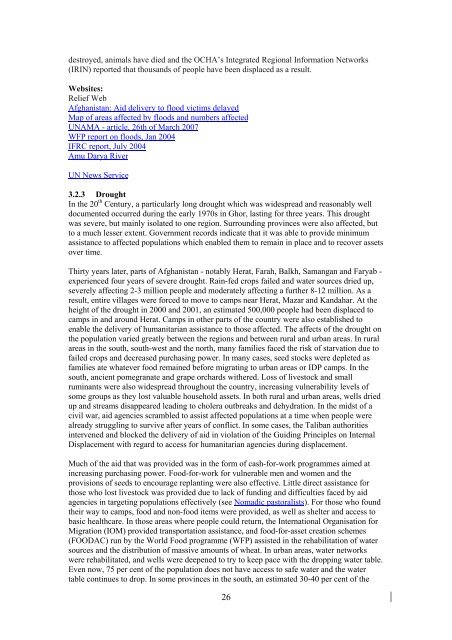Afghanistan. - Forced Migration Online
Afghanistan. - Forced Migration Online
Afghanistan. - Forced Migration Online
Create successful ePaper yourself
Turn your PDF publications into a flip-book with our unique Google optimized e-Paper software.
destroyed, animals have died and the OCHA’s Integrated Regional Information Networks<br />
(IRIN) reported that thousands of people have been displaced as a result.<br />
Websites:<br />
Relief Web<br />
<strong>Afghanistan</strong>: Aid delivery to flood victims delayed<br />
Map of areas affected by floods and numbers affected<br />
UNAMA - article, 26th of March 2007<br />
WFP report on floods, Jan 2004<br />
IFRC report, July 2004<br />
Amu Darya River<br />
UN News Service<br />
3.2.3 Drought<br />
In the 20 th Century, a particularly long drought which was widespread and reasonably well<br />
documented occurred during the early 1970s in Ghor, lasting for three years. This drought<br />
was severe, but mainly isolated to one region. Surrounding provinces were also affected, but<br />
to a much lesser extent. Government records indicate that it was able to provide minimum<br />
assistance to affected populations which enabled them to remain in place and to recover assets<br />
over time.<br />
Thirty years later, parts of <strong>Afghanistan</strong> - notably Herat, Farah, Balkh, Samangan and Faryab -<br />
experienced four years of severe drought. Rain-fed crops failed and water sources dried up,<br />
severely affecting 2-3 million people and moderately affecting a further 8-12 million. As a<br />
result, entire villages were forced to move to camps near Herat, Mazar and Kandahar. At the<br />
height of the drought in 2000 and 2001, an estimated 500,000 people had been displaced to<br />
camps in and around Herat. Camps in other parts of the country were also established to<br />
enable the delivery of humanitarian assistance to those affected. The affects of the drought on<br />
the population varied greatly between the regions and between rural and urban areas. In rural<br />
areas in the south, south-west and the north, many families faced the risk of starvation due to<br />
failed crops and decreased purchasing power. In many cases, seed stocks were depleted as<br />
families ate whatever food remained before migrating to urban areas or IDP camps. In the<br />
south, ancient pomegranate and grape orchards withered. Loss of livestock and small<br />
ruminants were also widespread throughout the country, increasing vulnerability levels of<br />
some groups as they lost valuable household assets. In both rural and urban areas, wells dried<br />
up and streams disappeared leading to cholera outbreaks and dehydration. In the midst of a<br />
civil war, aid agencies scrambled to assist affected populations at a time when people were<br />
already struggling to survive after years of conflict. In some cases, the Taliban authorities<br />
intervened and blocked the delivery of aid in violation of the Guiding Principles on Internal<br />
Displacement with regard to access for humanitarian agencies during displacement.<br />
Much of the aid that was provided was in the form of cash-for-work programmes aimed at<br />
increasing purchasing power. Food-for-work for vulnerable men and women and the<br />
provisions of seeds to encourage replanting were also effective. Little direct assistance for<br />
those who lost livestock was provided due to lack of funding and difficulties faced by aid<br />
agencies in targeting populations effectively (see Nomadic pastoralists). For those who found<br />
their way to camps, food and non-food items were provided, as well as shelter and access to<br />
basic healthcare. In those areas where people could return, the International Organisation for<br />
<strong>Migration</strong> (IOM) provided transportation assistance, and food-for-asset creation schemes<br />
(FOODAC) run by the World Food programme (WFP) assisted in the rehabilitation of water<br />
sources and the distribution of massive amounts of wheat. In urban areas, water networks<br />
were rehabilitated, and wells were deepened to try to keep pace with the dropping water table.<br />
Even now, 75 per cent of the population does not have access to safe water and the water<br />
table continues to drop. In some provinces in the south, an estimated 30-40 per cent of the<br />
26
















